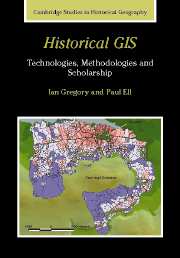Book contents
- Frontmatter
- Contents
- List of figures
- List of tables
- Acknowledgements
- 1 GIS and its role in historical research: an introduction
- 2 GIS: a framework for representing the Earth's surface
- 3 Building historical GIS databases
- 4 Basic approaches to handling data in a historical GIS
- 5 Using GIS to visualise historical data
- 6 Time in historical GIS databases
- 7 Geographic Information Retrieval: historical geographic information on the internet and in digital libraries
- 8 GIS and quantitative spatial analysis
- 9 From techniques to knowledge: historical GIS in practice
- References
- Index
8 - GIS and quantitative spatial analysis
Published online by Cambridge University Press: 23 June 2009
- Frontmatter
- Contents
- List of figures
- List of tables
- Acknowledgements
- 1 GIS and its role in historical research: an introduction
- 2 GIS: a framework for representing the Earth's surface
- 3 Building historical GIS databases
- 4 Basic approaches to handling data in a historical GIS
- 5 Using GIS to visualise historical data
- 6 Time in historical GIS databases
- 7 Geographic Information Retrieval: historical geographic information on the internet and in digital libraries
- 8 GIS and quantitative spatial analysis
- 9 From techniques to knowledge: historical GIS in practice
- References
- Index
Summary
8.1 INTRODUCTION
As a tool, GIS is well suited to storing and manipulating large volumes of complex spatially referenced data. The challenge for the researcher is to turn these data into understanding and meaning. This usually involves simplifying the data sufficiently to make them comprehensible, while avoiding making them over-simplistic. Mapping is one approach to doing this, but, as Chapter 5 described, it has some important limitations. Spatial analysis is another approach that complements mapping. The spatial component of data in a GIS are fundamentally quantitative, as they consist of co-ordinate pairs – numbers that can be manipulated mathematically. Spatial analysis makes use of this to allow us to either summarise the patterns within spatial data, or to ask how attribute data are arranged in space. Having said this, the quantitative nature of spatial data does not mean that spatial analysis is necessarily positivist. In many ways, it can be the reverse, as rather than trying to produce aggregate summaries of an entire study area, it allows us to explore how different parts of the map behave differently. Therefore, rather than searching for similarities, much of spatial analysis is concerned with establishing how different places behave differently.
There are three broad approaches to spatial analysis. The first merely simplifies the map, using forms of smoothing to attempt to enhance the spatial patterns in the data. For example, smoothing a point pattern representing cases of a disease into a raster surface may help detect whether the pattern clusters, and if so, where.
- Type
- Chapter
- Information
- Historical GISTechnologies, Methodologies, and Scholarship, pp. 161 - 182Publisher: Cambridge University PressPrint publication year: 2007



